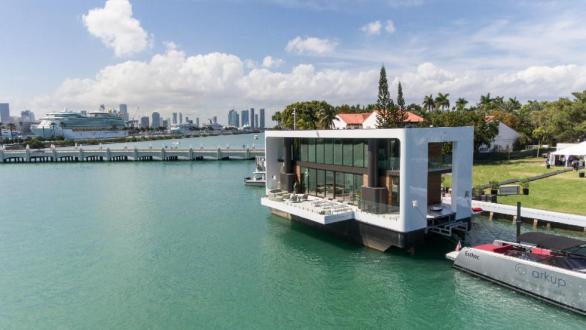As sea levels rise, architects are brainstorming ways to make homes more resilient to flooding. A floating unit is being singled out as a living solution for coastal areas.
Oceanix, a nonprofit that designs and builds floating cities, and the MIT Center for Ocean Engineering are showing off a futuristic concept of a floating city. The floating communities can expand, contract, and combine to form cities in prefabricated hexagonal islands of 4.5 acres that are able to house up to 300 people. Combine six of these islands and you could have a small city of 10,000, they estimate.
Modular floating villages could be clustered around a central port that offers shopping, health care, and other businesses. The islands would be designed to be self-sufficient, growing their own food and purifying their own water.
Researchers estimate that 90 percent of the world’s largest cities could be exposed to rising sea waters over the next few decades. Up to 2.4 million homes and more than 100,000 commercial properties are at risk of chronic flooding over the next 30 years, warns a 2018 report from the Union of Concerned Scientists.
Architects are responding to the warnings, and are even making disaster-proof homes available now—for a hefty price. The Florida company Arkup recently touted the houseboat of the future—an “electrical livable yacht,” which combines a luxury yacht, waterfront villa, and a floating motor home, all incorporating self-sustainability. It boasts 2,300 square feet of rooftop solar panels to power it at shore. But it’s getting lots of buzz for its apparent ability to withstand a Category 4 hurricane.
The Arkup, divided between the main and upper decks, boasts 4,350 square feet of indoor and outdoor living space. It’ll be costly to buy; the purchase price starts at $5.5 million and goes up to $12 million.
Adding Resilience to Homebuilding
Prices remain high for disaster-proof homes, but as disasters mount, will buyers be willing to pay more for resilient architecture?
“Resilient buildings provide value for our stakeholders because they withstand extreme weather and natural disasters more effectively, and they reduce the cost and waste associated with damage and reconstruction,” according to “A Culture of Resilience,” a sustainability report from Prologis, a warehouse firm that has about 3,200 facilities across 19 countries.
Prologis has outfitted its Japanese warehouses with seismic isolation systems that are capable of absorbing earthquake shocks and also have back-up energy and water supplies, Forbes.com reports.
“When hurricanes and earthquakes hit North America and typhoons struck Japan last year, our buildings stood strong while our teams mobilized immediately—keeping our customers in business or putting them back in business quickly,” Prologis CEO Hamid Moghadam told Forbes.com.
More reports are calling for global real estate to do more to protect itself from natural-disaster threats. “Without substantial and sustained global mitigation and regional adaptation efforts, climate change is expected to cause growing losses to American infrastructure and property and impede the rate of economic growth over this century,” according to the 2018 U.S. National Climate Assessment report, issued by the U.S. Global Change Research Program, a program mandated by the U.S. Congress comprising 13 federal agencies.
Source: “Rising Seas & Bigger Hurricanes—No Problem With a Floating Home,” TopTenRealEstateDeals.com (April 2019); “Natural Disasters Are Fueling the Rise of Resilient Infrastructure,” Forbes.com (April 8, 2019); and “Could We Live in These Floating Cities in the Future?” Curbed.com (April 5, 2019)













